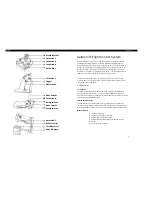
L90 LINE CURRENT DIFFERENTIAL SYSTEM – INSTRUCTION MANUAL
2-1
L90 Line Current Differential System
Chapter 2: Product description
Product description
This chapter outlines the product, order codes, and specifications.
2.1 Product description
The L90 Line Current Differential System is part of the Universal Relay (UR) series of products. It is a digital current
differential relay system with an integral communications channel interface. It is a complete line terminal protection and
control system, able to deliver protection as either a line differential and/or distance device. Both distance and line
differential elements can run simultaneously.
The L90 provides complete protection for transmission lines of any voltage level. Both three phase and single phase
tripping schemes are available. Models of the L90 are available for application on both two and three terminal lines. The
L90 uses per-phase-differential at 64 kbps transmitting two phaselets per cycle. The current differential scheme is based
on innovative patented techniques developed by GE. The L90 algorithms are based on the Fourier transform–phaselet
approach and an adaptive statistical restraint. The restraint is similar to a traditional percentage differential scheme, but is
adaptive based on relay measurements. When used with a 64 kbps channel, the innovative phaselets approach yields an
operating time of 1.0 to 1.5 cycles (typical). The adaptive statistical restraint approach provides both sensitive and accurate
fault sensing. This allows the L90 to detect relatively higher impedance single line to ground faults that existing systems do
not. The basic current differential element operates on current input only. Long lines with significant capacitance can
benefit from charging current compensation if terminal voltage measurements are applied to the relay. The voltage input
is also used for some protection and monitoring features such as directional elements, fault locator, metering, and
distance backup. In addition, the L90 provides local restricted ground fault protection.
The L90 operates over different communications links with various degrees of noise encountered in power systems and
communications environments. Since correct operation of the relay is completely dependent on data received from the
remote end, special attention must be paid to information validation. The L90 incorporates a high degree of security by
using a 32-bit CRC cyclic redundancy code (CRC) inter-relay communications packet.
Several options are available for communication. An RS232 port (USB port with the graphical front panel) can be used to
connect to a computer for the programming of settings and the monitoring of actual values. The rear RS485 port allows
independent access by operating and engineering staff. It can be connected to system computers with baud rates up to
115.2 kbps. All serial ports use the Modbus RTU protocol. The IEC 60870-5-103 protocol is supported on the RS485
interface. Also only one of the DNP, IEC 60870-5-103, and IEC 60870-5-104 protocols can be enabled at any time on the
relay. When the IEC 60870-5-103 protocol is chosen, the RS485 port has a fixed even parity and the baud rate can be
either 9.6 kbps or 19.2 kbps. The 100Base-FX or 100Base-TX Ethernet interface provides fast, reliable communications in
noisy environments. The Ethernet port supports IEC 61850, Modbus/TCP, TFTP, and PTP (according to IEEE Std. 1588-2008
or IEC 61588), and it allows access to the relay via any standard web browser (L90 web pages). The IEC 60870-5-104
protocol is supported on the Ethernet port. The Ethernet port also supports the Parallel Redundancy Protocol (PRP) of IEC
















































